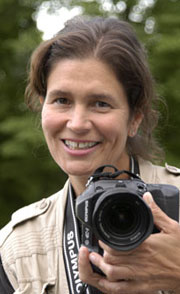 |
→ August 2005 Contents → Feature
|
The Hissing of Summer Lawns
|
 |
||||||
|
When I was much younger I said that I wanted to be a photographer because I wanted to articulate the ineffable. That desire still inspires what I do. I still want to capture the unspoken in the turn of a shoulder, the cast of an eye, the random arrangement of figures in a landscape, but what moves me in every picture that moves me is the light.
Over the past years I've worked with everything photographic. In addition to my Leicas and Nikons I've worked with Panfield, Deardorff, Mamiyaflex, Contax. I've made pinhole cameras; I've worked with the Holga, with the Widelux, and with the Hasselblad Superwide. Now, I mainly work with the Olympus E1 digital system and some 4x5 for architecture, but for me the tools were never that interesting or important — it was always about light. The tools help me channel that thought, impulse, instinct, whatever it is that makes me press the button, but the light is what moves me.
The way light fell across my face that afternoon in late August, the wet smells of a clearing storm infusing me, just for a second, with all the aromas of the earth: tomato leaves and basil and summer daylilies and blue hydrangeas and cut grass and bicycle oil and ripening peaches and the salt spray of the ocean.
Although my hoped-for memory of summer is sweet and gentle I sense something sinister brewing beneath the surface of some of these images. Are we happily watching fireworks or is that a nuclear flash? Is this a Popsicle or is it a weapon? Is she a girl lying in a still pool of ocean as the sun fades or is she a dead fish washed up on shore, helpless and alone? And something lonely: Are those boys by the watermelon even aware of each other? Do we ever connect? Is anyone at the cocktail party talking to anyone else? Is anyone having fun on the Fun Slide?
Some of these images were mistakes. I thought we were watching fireworks but when I saw the image, I wondered. I photographed the two girls at the carnival originally because I loved the freckles on one girl, but I didn't love the picture until I was editing it and read the other girl's T-shirt: "I traded my boyfriend in for a puppy." I wish life were that easy.
Carroll Bogert:
Anne Day's pictures of summer aren't about the summer we're all having now — gritty grown-up summers with mortgage payments and long lines at the rental car place and bra straps damnably determined to show beneath your sundress.
This is summer before you wore a bra. This is summer back when your Popsicle still fell off the stick; when you never brushed your hair. This is summer when you didn't notice its Americanness because that's all you knew, when you just enjoyed the fireworks and the cotton candy. This is the summer of baseball and ripe peaches and, in every frame, motherhood — because Anne Day is a mother and because this is the summer that every mother wants to give her children.
Feel it again, in every one of Anne's tender images. Feel one hand in the cold pond water just as you're taking the cartwheel plunge. Feel yourself airborne and weightless over the trampoline. Feel the creepy, tickly caterpillar on your arm, and the damp air rush past you on your bike just before the big rainstorm breaks, and the sprinkler pelting your naked skin. Feel how hot and languid the afternoon is as you stretch across the white bedspread. Remember how boring summer could be, too — deliciously boring and blank and long.
Even as children we sensed that summer was meant for us. But if you thought you'd never recapture those carefree moments, tarry a while in Anne Day's evocation of the season. Just like summer itself, you'll wish it could never end.
Christopher Hewat:
Summer is itself an island, separated by national holidays from the mainland responsibilities of school and work. Softened by heat and haze, the disciplined mind dissolves. Thought turns sensual; odors and tastes grow sharper, longings, more intense. Suspended on a hammock between the poles of June and September, the American mind succumbs to the American body.
Every summer chases other summers. The present pool stirs the memory of past pools. Except for the very young, what summer promises has already taken place. Photography, retrospective by nature, is the perfect match to summer's recapitulations.
Summer has a pact with the camera. Abundant summer sunlight, pouring over the country, arrests objects in a heightened, heroic brilliance and sets them against deep shadow. It vivifies colors, which leap from the world to the lens. In return for such light the camera gives summer its monuments. Saved in countless albums and shoeboxes is the same faded snap of neighborhood kids lined up on the diving board.
Anne Day's summer photographs are the production stills of a season's progress. Her chosen figures, mostly young, appear in mid-air, mid-thought, mid-childhood, bathed in a telling golden light. The clean naturalism of her well-constructed scenes pursues the romance of summers half-remembered, half-idealized. The photographic tenderness with which she regards her own children, who appear often in these images, extends to the entire cast of summer theater.
© Anne Day
|
|||||||
Back to August 2005 Contents
|
|

